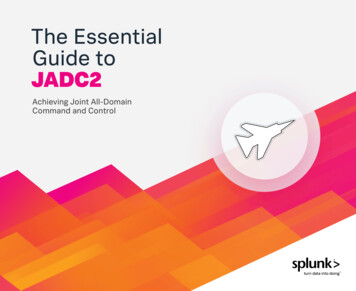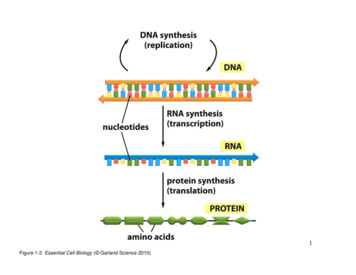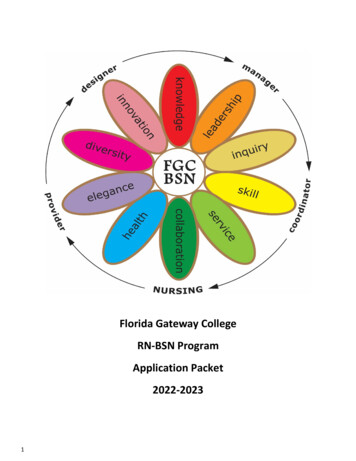
Transcription
The EssentialGuide toJADC2Achieving Joint All-DomainCommand and Control
Table of ContentsWhat is JADC2?.3The Challenges to Successful JADC2.4Compress the OODA Loop?.5Five pillars of a successful JADC2 .6See it in practice.7Use cases.7City of Los Angeles enables real-time security intelligenceacross 40 agencies. 7Saving lives with Splunk and Royal Flying Doctor Service. 8National Ignition Facility unlocks the potential of cleanenergy and safeguards the U.S. nuclear stockpile. 8Splunk brings data solutions to real-world problems.9Automation. 10Anomaly detection. 10Intelligent event management. 10Predictive analytics. 10SOC Automation. 10Orchestration. 10Incident response . 10Splunk — The Future of JADC2.11
What is JADC2?The Vision: Future of Joint WarfareJADC2, or Joint All-Domain Command and Control, is the emergingterm senior DoD officials are using to describe linking the correctdata to all warfighters for the best decisions and outcomes.Massive Input of InformationFor the first time, it’s realistic to imagine a scenario where highlyadvanced sensors deployed in ships, planes and tanks continuallyfeed critical, real-time information back to headquarters. Then, usingstate-of-the-art AI and machine learning (ML) tools, commandersVALIDATEanalyze the avalanche of incoming intelligence and make betterdecisions, faster.Distributed SystemThis technology is already benefiting spaces like human assistancein disaster relief (HAIDR), which often involves pulling data fromdisparate sources to make optimal decisions in real time. And, withANALYZEadvancements in cloud, connectivity and sensor technology, usingdata as a key asset has gone beyond the proving ground. It’s nowpossible to optimize operations on a global scale. A fully operationalJADC2 environment will leverage AI and ML to accelerate decisionsto machine speed across air, sea, undersea, land, space andcyberspace — automating processes and empowering actions atspeeds missions demand.“ We see JADC2 is absolutely core to theway we’re gonna defend the homeland.”— General Terrance O’ShaughnessyDecision PointOPTIONAOPTIONBOPTIONCORDERS ISSUEDExecutionThe Essential Guide to JADC2 Splunk3
The Challenges toSuccessful JADC2Challenges to Compressing the OODA LoopThe OODA Loop: Observe, Orient, Decide, ActJADC2 provides a necessary evolution for the armed forces becauseit operationalizes all battlefield data while enabling more confidentand rapid decision making by our nation’s warfighters. But it’s notwithout challenges. Compressing the OODA (short for observe, orient,OBSERVEACTdecide, act) Loop requires a more holistic approach to solve theemerging spectrum of challenges.It’s no longer enough to take a snapshot of all your systems at a point- Stovepipes UnstructuredDataStoragein-time, and then create a data model based on that static snapshot. Limited Meta Tagging Proprietary Controls Multiple Formats Security PolicyExamples of challenges decision makers face at each stage of theOODA loop include:ObserveOrientDecideActLimited MetataggingLimited AI and MLNo MDOVisualizationStovepipesUnstructured DataLimited AutomationManual COA/DEVInterface NotInteroperableMultiple FormatsSecurity PolicyManually IntensiveFusionSerial Data SharingProprietaryControlsDataCollectionNetworkand Access Weak Decision Support Serial Data Sharing No MDO Visualization Manual COV DEVDataManagement Interfaces Not Interoperable Limited AI & ML Manually Intensive Fusion Limited tedContestedPermissiveThe Essential Guide to JADC2 Splunk4
Compress theOODA Loop?Challenges to Compressing the OODA LoopThe OODA Loop: Observe, Orient, Decide, ActThe best way to compress the OODA Loop is to optimize the flowof data. Using a traditional approach, Combatant Commands mayneed to manually pull data points from disparate, disconnectedsystems, manually created data in formats like Excel or from legacyOBSERVEACTdatabases. This solution works as long as you have plenty of time towait for all of the relevant information. But on the battlefield, there isDataStorageno time to waste.Without a centralized platform to consolidate data, CombatantCommands must make life and death decisions without thebest available tactical information. In today’s world, traditionalapproaches don’t fit.This is where Splunk comes in, bringing data to every decision toeffectively compress the OODA Loop.DataCollectionNetworkand ghlyContestedContestedPermissiveThe Essential Guide to JADC2 Splunk5
Five pillars of asuccessful JADC2Operational AdvantageA JADC2 environment should be as easy to use as any consumer AutomatedActionFilter, mask,enrich, andaggregrate dataLeveragemultiple datasources for aholistic viewEasy toinvestigateand analyzeCreate robustvisualizationsAutomateroutine tasksand decreasetime to executeAnd that can be done with Splunk, as it takes a massive amount ofdisparate information (most of which is likely already available) andcondenses it into actionable intelligence. For example, IoT sensorson warfighters can provide a holistic view of the battlefield when feddirectly into Splunk.But fusing the data sources that are already at hand is just thebeginning. As you break down stovepipes and siloes, previouslydisconnected systems will be able to communicate the most up-todate information available. Decision makers can answer questionssuch as: Who is available? What effects (Kinetic, Non-Kinetic, or Cyber) are available? How long will it take to get there? What is the likelihood of success?“ We cannot deter what we cannotdefeat, and we cannot defeat thatwhich we cannot detect.”— General Terrance O’Shaughnessy What are the collateral effects?Data is displayed in an easy-to-use format — similar to a rideshareor delivery app. Combatant Commands will execute their operationswith the best possible data available, and they will be able toadapt and change strategies as adversaries adapt and newchallenges arise — using a single interface to collate structured andunstructured data. A JADC2 environment improves coordination andincreases interoperability among the branches of the U.S. military byleveraging technology and real-time data.There are strong examples from both the public and private sectorof how Splunk’s AI /ML capabilities can help accomplish the abovethrough anomaly detection, predictive analytics and clustering.Regardless of whether the mission is routing supplies, medicalassistance, or deploying forces to ensure mission success, rapidinformation flow and decision support is critical.6
See it in practiceUse casesHAIDR missions often involve pulling data from disparate sourcesCity of Los Angeles enables real-time securityintelligence across 40 agenciesto make optimal decisions in real time. The data used to make theseTo protect its digital infrastructure, the City of Los Angeles requiresdecisions might come from weather alerts and forecasts, socialthreat intelligence and situational awareness of its security posture.media messaging, email or state department reports. This is justPreviously, the city’s more than 40 agencies had disparate securityone example of how customers are already using Splunk to gain anmeasures that complicated data analysis. Los Angeles turnedoperational advantage. School districts, firefighters, city plannersto Splunk to assess citywide risks, gain visibility into suspiciousand the Department of Energy’s National Ignition Facility (NIF)activities and proactively mitigate threats.are among the growing number of customers relying on Splunk tostreamline operations.Business impact: Created an integrated citywide security operations center (SOC) Increased protection for digital assets, infrastructure andpublic services Enabled threat intelligence and real-time, 24/7 networksurveillance across the cityThe city now uses Splunk to ingest raw logs and other data from itsmore than 40 departments. Splunk then integrates this informationinto an integrated SOC where the team can analyze and visualize thedata in easy-to-use dashboards. With this unified view, executivesand analysts can monitor malware, identify top attackers and theirtargets, and have always-available situational awareness of securityevents to make the city a safer place for its citizens.7
Saving lives with Splunk and Royal FlyingDoctor ServiceNational Ignition Facility unlocks the potential of cleanenergy and safeguards the U.S. nuclear stockpileThe Royal Flying Doctor Service of Australia (RFDS) is one of theThe National Ignition Facility (NIF), located at California’s Lawrencelargest and most comprehensive aeromedical organizations inLivermore National Laboratory, is the world’s largest laser. To supportthe world. This nonprofit organization provides emergency andthe NIF’s core missions, including nuclear stockpile stewardshipprimary healthcare services for those living in rural, remote areas ofand scientific discovery, scientists and engineers require a secure,Australia — people who cannot access a hospital or general practicereliable IT infrastructure. Splunk Enterprise and Splunk IT Servicedue to the vast distances of the Outback.Business impact: Centralized data analytics and monitoring to deliver critical care to290,000 patients annually Enabled real-time alerts on the temperature of refrigeratedvaccines and medicines, which has optimized medicine deliveryand reduced waste Delivers detailed information to donors, communicating life-savingmissions performed in their sponsored regionIntelligence (ITSI) now sit at the heart of the NIF’s control system,which manages more than 66,000 control points to power NIF’smassive laser facility.Business impact: Maximized system uptime and performance Improved control systems reliability, enabling the team to maintainthe necessary systems to double the number of laser shotexperiments from 200 to 400 annually Ensures the health of more than 66,000 Internet of Things (IoT)devices, in addition to the IT infrastructureRFDS’s fleet of 63 aircraft — which makes them Australia’s thirdlargest airline — produces large volumes of avionics and location dataAfter bringing network, authentication and host data into Splunkas it covers its “waiting room,” which spans four-thousand squareto solve security challenges, the team aggregated this data withmiles. Splunk dashboards provide real-time visibility into the statusa variety of other sources to gain real-time visibility across theand movements of the fleet, equipping RFDS with the information itfacility. The lab’s engineers can now take action on events based onneeds to efficiently deliver critical health services in circumstanceseverything from application data to sensor data like laser voltage,where every second counts.temperature and pressure.8
Splunk bringsdata solutions toreal-world problemsThe above examples are a product of the effective use of theseOperations ImprovementsSpeedConfidenceFaster decisionmakingHigher confidencein decisionsInsightsAgilityGreater situationalawarenessAbility to adaptto changesSplunk solutions. Fusing AI and ML with automation and adaptiveresponse capabilities can lead to effective critical operations andcontribute to mission success.Deploy Splunk Data Stream Processor to: Turn raw data into high-value information Take action on the data in motion Protect sensitive data Distribute data to multiple destinationsDeploy Splunk Enterprise to: Monitor every aspect of a mission Monitor complex systems Provide complete operating picture Reduce downtimeDeploy Splunk Phantom for: Automated dispatch Multi-sensor notifications Predictive response9
Unlike legacy data platforms and siloed monitoring tools, SplunkSOC Automationoffers a cost-effective, extensible and massively scalable analyticsPhantom enables teams to work smarter by executing automatedplatform that delivers enterprise-wide visibility across cloud, on-actions across their security infrastructure in seconds, versus hourspremises and hybrid system deployments, enabling agencies to reuseor more if performed manually. Teams can codify workflows intodata to overcome challenges across discrete programs and missionPhantom’s automated playbooks using the visual editor (no codingobjectives. Splunk empowers teams to turn data into action through:AutomationAn operational JADC2 provides a significant advantage —required) or the integrated Python development environment. Byoffloading these repetitive tasks, teams can focus their attention onmaking the most mission-critical decisions.automatically collecting and correlating data from disparate sourcesOrchestrationinto complete services, increasing the speed and accuracy ofPhantom is the connective tissue that lets existing security tools workidentifying necessary relationships. Once an organization has a goodbetter together. By connecting and coordinating complex workflowshandle on correlating and analyzing data streams, the next step is toacross the SOC’s team and tools, Phantom ensures that each partautomate responses to abnormal conditions.of the SOC’s layered defense is actively participating in a unifiedAnomaly detectionUse historical data to alert on unexpected behavior for one ormultiple events. Patterns are continuously updated in real time.Intelligent event managementCollect and enrich events from multiple sources into a single alertingframework. Real-time, automated event correlation triggers alertsas data enters the system, using out-of-the-box (OOTB) machinelearning policies for immediate noise reduction. Incidents areautomatically prioritized by service score and impact.Predictive analyticsPredict future incidents 30 minutes in advance using machinelearning algorithms and historical service health scores. The top fivecontributing service metrics are displayed to guide troubleshooting.defense strategy. Powerful abstraction allows teams to focus on whatthey need to accomplish, while the platform translates that into toolspecific actions.Incident responsePhantom helps security teams investigate and respond to threatsfaster. Using Phantom’s automated detection, investigation andresponse capabilities, teams can execute response actions atmachine speed, reduce malware dwell time and lower their overallmean time to resolve (MTTR). And now with Phantom on Splunk Mobile, analysts can use their mobile device to respond to securityincidents while on-the-go. Phantom’s event and case managementfunctionality can further streamline security operations. Case-relateddata and activity are easily accessible from one central repository. It’seasy to chat with other team members about an event or case, andassign events and tasks to the appropriate team member.10
Splunk — TheFuture of JADC2The time it takes to get intelligence from the places where soldiers,sailors and airmen are operating up to the highest level of authority iscritical. A fully operational JADC2 environment will give CombatantCommands the tools to observe, orient, decide and act in near realtime. Splunk will allow the DoD to fully or partially automate theDecision and Action portion of the OODA Loop, allowing decisions atthe speed of relevance.It all points to JADC2 becoming the cornerstone for modernbattlefield operations and deterrence, at a time when civiliantechnologies — like apps to locate the nearest gas station or whereyou left your phone — set the pace for the degree of connectivity andintuitive use that battlefield commanders should expect.Gaining an operational advantage over adversaries is key to missionsuccess. With access to artificial intelligence, machine learning, andhigh-quality data streaming, the military service branches can nowset a higher standard for communication and information-sharing.The Essential Guide to JADC2 Splunk11
Learn More.Ready to learn more about how the Data-to-Everything Platformcan contribute to a successful JADC2? Speak with a Splunk expertto discuss your environment and assess your requirements.Speak to an ExpertSplunk, Splunk , Data-to-Everything, D2E and Turn Data Into Doing are trademarks and registered trademarks of Splunk Inc.in the United States and other countries. All other brand names, product names or trademarks belong to their respectiveowners. 2020 Splunk Inc. All rights 5
through anomaly detection, predictive analytics and clustering. Regardless of whether the mission is routing supplies, medical assistance, or deploying forces to ensure mission success, rapid information flow and decision support is critical. "We cannot deter what we cannot defeat, and we cannot defeat that which we cannot detect."










